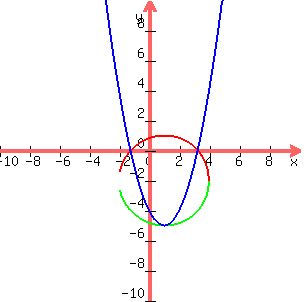Question 1082996: C is a circle centered at (1,-2) with radius 3. Q is a quadratic function with the same x-intercepts as C and whose vertex is on C.
(a) write an equation for C and find itís x-intercepts.
(b) Find All Possible equations for the quad Q and explain how you know that the equations you have given are the only ones that will work
Answer by Boreal(15235)   (Show Source): (Show Source):
You can put this solution on YOUR website! The circle is (x-1)^2+(Y+2)^2=9
the quadratic function has the same x-intercepts.
The x-intercepts of the circle are where y=0, and the equation is x^2-2x+1+4=9
x^2-2x-4=0
x=(1/2)(2+/-sqrt(4+16)=(1/2)(2+/- 2 sqrt (5)=1+/-sqrt (5)
If the vertex is on the circle, it has to be symmetrical with the x-value of the center, so that x=1
But the vertex x-value equals -b/2a, so -b/2a=1 and b=-2a
Therefore, ax^2+bx+c=0 and ax^2-2ax+c=0
substituting the values of the roots for x
a(1+ sqrt(5)^2-2a(1+sqrt(5))+c=0
a(6+2 sqrt(5))-2a(1- sqrt(5))+c=0
6a +2a sqrt(5)-2a+2a sqrt(5)+c=0
4a+c=0
c=-4a
and ax^2+bx+c becomes ax^2-2ax-4a=0, which is a(x^2-2x-4)=0 which is the above.

There is another that has a negative leading coefficient, and that has an intercept -1/5 of the other, so it is the same quadratic with a=-0.2. 

There can't be other equations, because they would have a vertex on another part of the circle and for the roots to match, the vertex has to be at x=1.
|
|
|